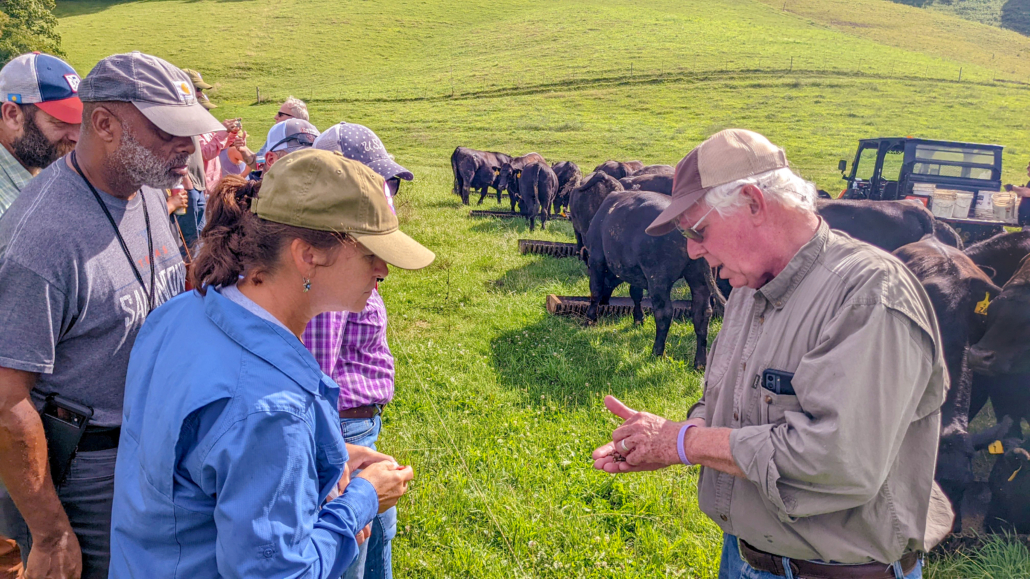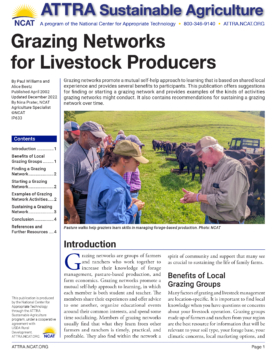Grazing Networks for Livestock Producers

Pasture walks help graziers learn skills in managing forage-based production. Photo: NCAT
By Paul Williams, Alice Beetz, and Nina Prater, NCAT Agriculture Specialists
Abstract
Grazing networks promote a mutual self-help approach to learning that is based on shared local experience and provides several benefits to participants. This publication offers suggestions for finding or starting a grazing network and provides examples of the kinds of activities grazing networks might conduct. It also contains recommendations for sustaining a grazing network over time.
Introduction
Grazing networks are groups of farmers and ranchers who work together to increase their knowledge of forage management, pasture-based production, and farm economics. Grazing networks promote a mutual self-help approach to learning, in which each member is both student and teacher. The members share their experiences and offer advice to one another, organize educational events around their common interests, and spend some time socializing. Members of grazing networks usually find that what they learn from other farmers and ranchers is timely, practical, and profitable. They also find within the network a spirit of community and support that many see as crucial to sustaining the life of family farms.
Benefits of Local Grazing Groups
Many factors of grazing and livestock management are location-specific. It is important to find local knowledge when you have questions or concerns about your livestock operation. Grazing groups made up of farmers and ranchers from your region are the best resource for information that will be relevant to your soil type, your forage base, your climatic concerns, local marketing options, and more. While information on the Internet and in books can be helpful, it is important to supplement that information with local knowledge.
Finding a Grazing Network
If you are interested in being part of a local grazing group, the easiest thing to do is find an established network that is already functioning in your area. You can ask your local Extension agent if they are aware of any in operation. Sometimes agents themselves are the grazing group coordinators. Your local NRCS office or Conservation District might also have information on local groups. The National Grazing Lands Coalition also has a listing of state grazing coalitions.
You can also search at NCAT’s Soil for Water website. This network of farmers is focused on grazing to improve water infiltration and retention by building soil and pasture health.
Starting a Grazing Network
If you cannot find a grazing group in your area that suits your purposes, you can easily start your own. Grazing networks can be as simple as a small group of graziers who know each other socially deciding to intentionally pool their knowledge to help one another out. With a little effort, it can grow from there to include the farming and ranching community at large. One or two people usually take on a leadership role to coordinate events and invite the community by word of mouth, through email, using social media, or with the old-fashioned, but effective, method of putting up flyers in feed stores and post offices.
Group Structure and Leadership
Grazing group structures can vary widely, but whatever form they take, they usually have the same goal in common: farmers supporting fellow farmers in trying to learn ways to improve their operations.
Although Extension agents do act as coordinators for some grazing networks, the “leadership should really come from within the group… [and] members themselves must lead the network” (Cadwallader, 1999). As one observer explains, “This is in fact the heart of a grazing network: the experts are the ones doing it, and the ones doing it are the farmers” (Baker, 1997).
Some grazing groups are large and have a body of officers to help manage memberships, schedule events, and recruit new participants. Others are small and informal, with the leadership role shifting as needed. Whatever group you form, keep in mind that some formal structure can help avoid confusion and keep the group active and on track.
Before You Meet
Ask these questions before putting on grazing group events, in order to make the events as helpful and positive as possible:
What is the purpose of this event?
Be specific. Is it to share information about a specific tool, method, or issue? Is it to introduce new graziers to regenerative grazing? Is it to discuss drought management strategies? Is it to socialize with other likeminded people? These are examples of possible purposes an event could have. You can see that how you answer this question makes a big difference to the resulting structure and content of what you plan. Spend some time thinking about and discussing this question, as simple as it may seem.
Who is this event for?
Will it be open to anyone interested, or limited to a few folks you know personally? There are a lot of farmer and rancher support groups and events that target specific sub-groups: women, veterans, BIPOC farmers, farmers in the LGBTQ+ community, Spanish-speaking farmers, and more. A grazing network or event could be open to everyone, or it could be more narrowly focused, depending on its purpose. Just keep in mind that having both beginning and experienced graziers is a key ingredient of successful groups.
Examples of Grazing Network Activities
Broadly speaking, the purpose of a grazing network is for graziers to be able to connect and share practical knowledge with each other. This can be done in a variety of ways.
Virtual Connection
The COVID-19 pandemic forced many people to become more tech savvy, and virtual meetings of all kinds have become commonplace. Though rural areas sometimes struggle with reliable Internet, virtual events can be a great option for shorter gatherings (an hour or two), or where travel is a barrier to participation. Virtual gatherings can include a designated presenter, or they can be as simple as a chat among producers, or a mix of the two. Virtual events can provide many of the same benefits to grazing network members as in-person meetings, and they can save members from having to drive long distances.
In-Person Connection
In-person connection is beneficial in many ways. Pasture walks are common events for grazing groups, and nothing compares to seeing in-person how others implement managed grazing: different techniques, tools, soils, topographies, plant species, livestock handling systems, watering systems, and more. Walking the fields as a group, hearing a farm’s history, practices, successes, challenges, and goals can be an invaluable training opportunity.
Pasture walks are often concluded with a potluck supper. This social component is vital to a grazing group’s sustainability (Baker, 1997; Cadwallader, 1999). Farmers have long days, and sometimes it feels like there are eight of those long days every week. Farmsteads may be far apart, and farm life often leaves little time for a social life, let alone meeting new people. Being a member of a grazing group not only provides farmers with practical information, it also creates a social circle of like-minded folks who gather regularly to discuss their common interests and to have fun.
The social benefits of grazing groups are not just a side benefit—they are a critical component. Social networks are key to farmer well-being. Farm stress, combined with isolation, can lead to serious mental health struggles for farmers. Maintaining a social network with people who understand your work will help make the bad days easier to bear and the good days even better. (Find Farmer Well-Being resources on the ATTRA website.)
Practical Considerations for In-Person Events
These suggestions may seem like common sense, but if you have never organized an on-farm event, you may not have thought of some of these practicalities:
- Directions. Google maps aren’t always accurate in rural areas. Provide written directions if the farm is difficult to find.
- Safety. Make sure the host farmer gives a safety talk to make everyone aware of potential hazards like electric fence, aggressive animals, ankle-twisting holes, etc.
- Biosecurity. Disinfectant spray or foot baths for boots can help prevent the transfer of various livestock diseases.
- Weather. Make sure people are prepared for heat or cold, and always reschedule if lightning or other serious hazards are a risk.
- Accessibility. Make sure people with different physical abilities are considered. Bringing folding chairs or stools for farm tours can help and, if necessary, load up a trailer with hay bales for longer tours.
- Sound. Small, portable microphone/speaker sets are relatively inexpensive and can help everyone in the group hear the presenter.
- Food. Potlucks can be highly coordinated or loosely organized. Make sure people with dietary restrictions are accommodated.
- Bathrooms. Make sure a bathroom is available. If necessary, rent a port-a-potty for events. Large groups can strain septic systems.
- Other useful things to have on hand: water, sunscreen, bug spray, basic first-aid kit.
Sustaining a Grazing Network

Photo: NCAT
Grazing networks take time and energy to run. Leaders who coordinate activities and members who participate in those activities are giving up free time and putting in the work to make these things happen. This energy and commitment level naturally waxes and wanes as members’ needs and circumstances change over time. For grazing networks to continue in the long run, energy must be put into sustaining them.
In order to continue in the long term, any group may need to change and evolve. As graziers gain experience, they may need to bring in outside experts to increase their knowledge even further. Mentees may find themselves being mentors eventually. The group may find that instead of monthly gatherings, quarterly gatherings are more doable. Communication and flexibility among members will help keep the group’s activities relevant and sustainable in the long term.
Groups that want to continue long-term should also make an effort to recruit new members on a continuous basis to bring in new energy and keep numbers up, as other members may leave the group. Fresh faces can help enliven conversations and bring new energy to a flagging group.
Conclusion
Establishing and maintaining a grazing network is challenging. It demands leadership, commitment, time, energy, and creativity. Also, balancing the different needs and expectations of the members will be an ongoing task. That hard work and dedication will, however, be rewarded. The educational, social, and economic benefits that farmers discover in grazing groups far outweigh the effort necessary to make them work.
References
Baker, Juli. 1997. A grazing network: In the beginning…. Pasture Talk. March. p. 11.
Cadwallader, Tom. 1999. Strengthening farmer networks. Pasture Talk. August. p. 7.
Further Resources
NATGLC State Coalitions, National Grazing Lands Coalition
Grazing Networks for Livestock Producers
By Paul Williams and Alice Beetz
Published April 2002
Updated December 2022
By Nina Prater, NCAT Agriculture Specialist
©NCAT
IP633
This publication is produced by the National Center for Appropriate Technology through the ATTRA Sustainable Agriculture program, under a cooperative agreement with USDA Rural Development. ATTRA.NCAT.ORG


